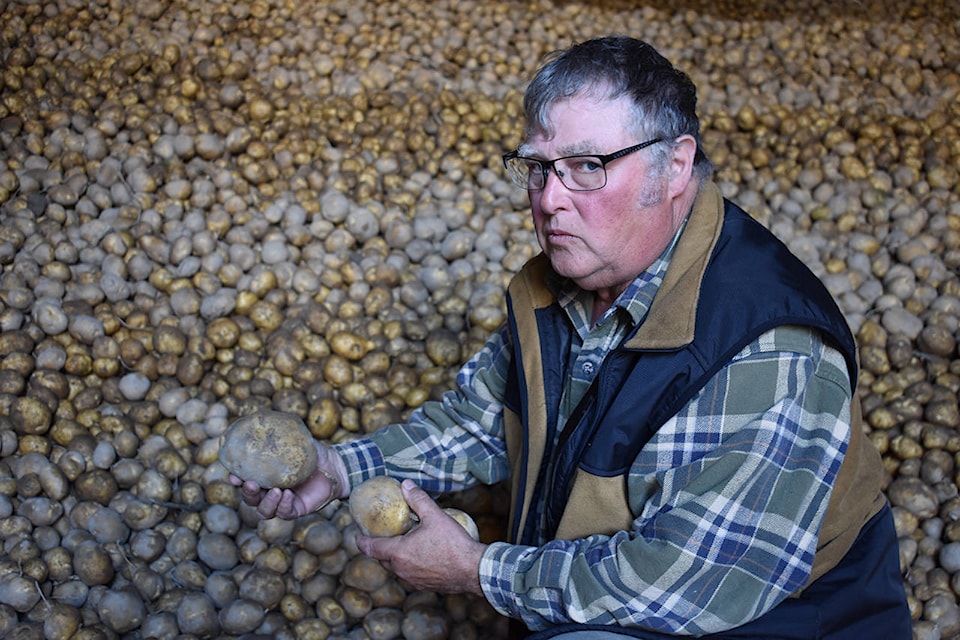When you’ve been in the farming business as long as Hugh Reynolds, you know it’s always changing.
The 67-year-old Delta potato farmer has been working the fields “from the time that I could hold a hoe and knew the difference between strawberries and weeds,” he said. When he started at age seven on his father’s farm, the potatoes were picked by hand, put into sacks and hauled onto the tractor Reynolds used to drive.
Now, the potatoes are sorted through a machine and moved into a barn using a conveyor belt. Newer machines and younger farmers are using even faster harvesting methods, and utilizing GPS to sow even straighter rows of vegetables.
It’s a changing industry, something Reynolds accepts.
“We live with change,” he said. “The business of farming is constantly changing as the world changes. And whatever the world wants, we will grow.”
Every five years, the Canadian Census of Agriculture documents that change, noting the number of dairy cows, the acres of wheat and the age of farmers at that point.
In Delta, the Census of Agriculture has been cataloguing the transformation of a strong agricultural community — vociferously championed by South Delta MLA and city councillor Ian Paton — that is becoming more diverse as time passes.
There are more than 23,000 acres of Delta land in the agricultural land reserve. And in 2016, there were 185 different farms in the municipality.
Delta’s mainstay crop, as shown in the infographic above, is potatoes. According to Reynolds, who also grows peas and yellow wax beans on his farm, everything rotates around the potato fields.
“Some guys have cattle. Some guys have hay. Some guys have cabbages,” he said. “Everybody’s business plan is different. But it all, for field crops, it’s all dependent on potatoes.”
Since 2006, Delta’s potato acreage has been decreasing: going from just over 4,000 acres to barely over 3,000.
In part, this is because of the municipality’s aging farmers.
The average age for a farmer in Delta is now over 55. Although still younger than the average farmer in Greater Vancouver and B.C. — 56.7 and 56.3, respectively — it’s still significant in an industry that continues to survive on hard labour.
Reynolds is one of those aging farmers.
“I am quitting growing potatoes because I am too old and my wife has got a bad leg,” he said. “So we’re phasing out.”
In the past, Reynolds grew more than 100 acres of potatoes on his Westham Island farm. This year, he grew just 40. Next year, it will be down to 30 acres, and then he will be done.
It’s a trend that Reynolds is seeing repeated among his colleagues across Delta.
“Either they’ve grown older, they’ve had heart attacks, or they’ve just gotten — it’s hard work. It’s the hardest thing I do,” he said.
“People worry that the number of farmers is decreasing,” he continued. “And so, they worry about the farmers are all getting old. And they’re concerned: well if the farmers are dying off, do we have a concern about our food source?”
The answer, according to Reynolds, is no.
“With the new varieties, we can grow more potatoes on the same land than we ever could before,” he said.
“Conventional crops are getting bigger. The greenhouse business is getting bigger. The blueberry business, the bushes that we planted, are increasing. So the crops are getting better.”
On the same amount of land, farmers can produce more food. New machinery means more efficient harvesting and planting. And retirees will often rent their land out to young farmers looking to get a foothold in the industry.
Reynolds will be renting his land to his young neighbour, who also intends to grow potatoes.
“He just wants to grow potatoes, and I can still survive by renting my potato land to him and growing peas and beans,” he said. “They can do more fields, and that means that we don’t have to do as many.”
And that’s something the Census of Agriculture won’t be able to capture.
Efficiencies, as well as consumer desire, drive change in farming. When dairy cows were prominent, milking was done by hand. Now, mechanical milkers mean 11 farms in Delta are able to milk over 2,000 cows.
The same pattern can be seen in the potatoes too. As fewer farms are needed to produce the same amount potatoes, farmers are looking to other crops. This time, it’s corn produced as feed for the dairy farms out in Chilliwack, Reynolds said. That corn acreage has more than doubled in the last five years.
“Our business is always subtly changing,” Reynolds said.
“But if you, or your mother or your grandmother, had driven down Westham Island Road, you would not — unless the cheques were coming to you — you would not know the difference.”
grace.kennedy@northdeltareporter.com
Like us on Facebook and follow us on Twitter
